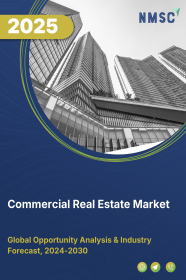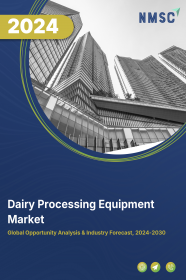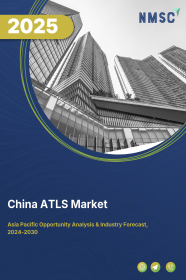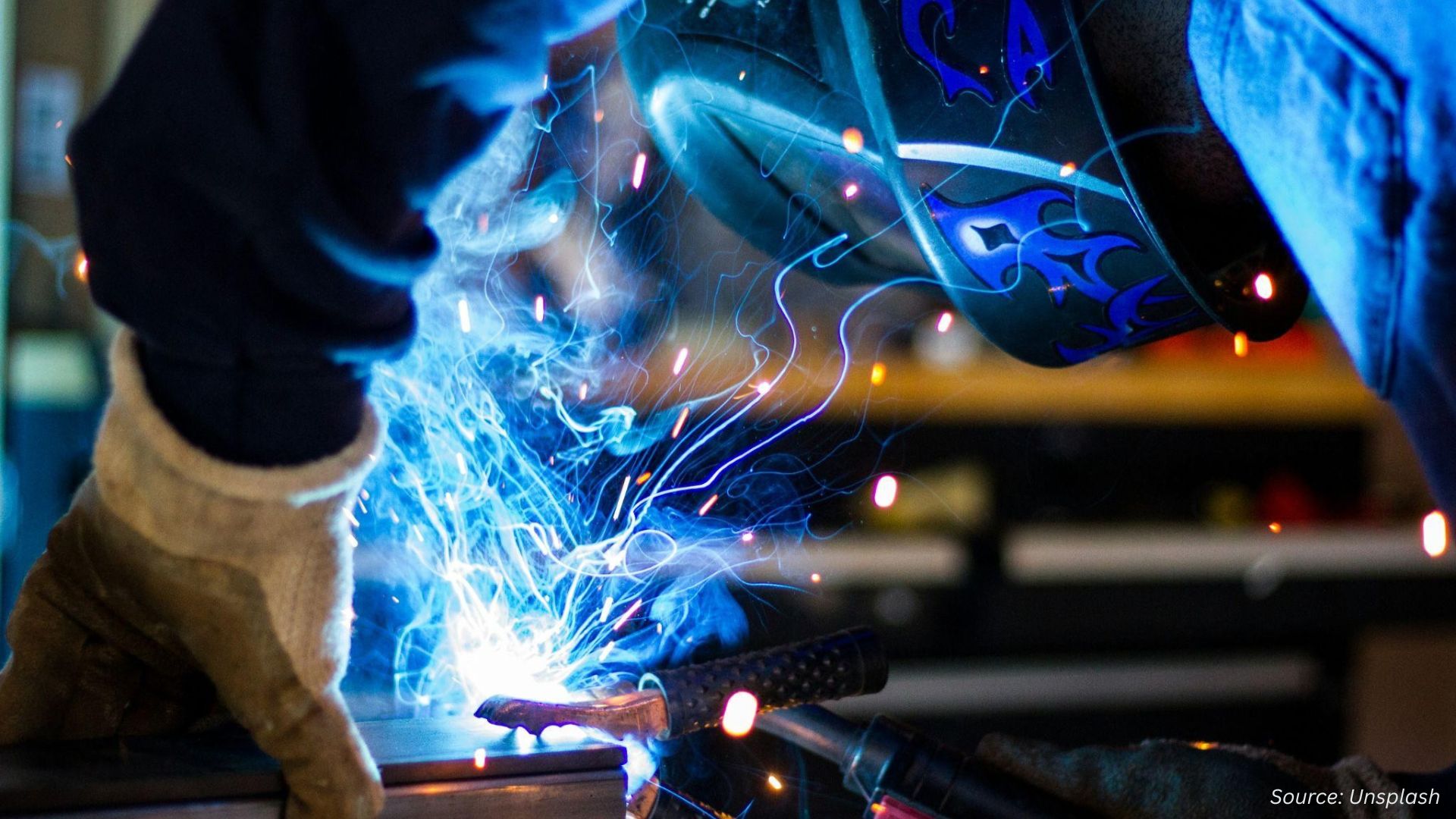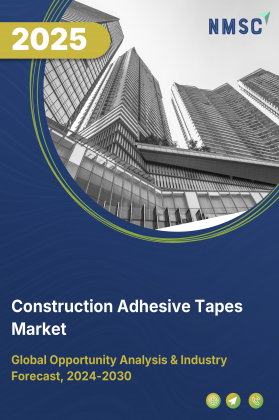
Construction Adhesive Tapes Market by Tape Type (Single-sided, Double-sided, Sealing & Waterproofing, Surface Protection & Speciality, Functional Technical and Others), by Technology (Solvent-based, Hot-Melt Based, Water Based and Others), by Resin Type (Acrylic, Rubber and Others), by Application (Flooring, HVAC & Insulation and Others) and by End User (Residential, Commercial and Others)– Global Opportunity Analysis and Industry Forecast, 2025–2030
Construction Adhesive Tapes Industry Outlook
The global Construction Adhesive Tapes Market size was valued at USD 3.11 billion in 2024, with an estimation of USD 3.29 billion in 2025 and is predicted to reach USD 4.36 billion by 2030 with a CAGR of 5.8% from 2025-2030.
The market is gaining prominence as a vital component of modern building practices, driven by the need for efficient, durable, and sustainable bonding solutions across applications such as flooring, roofing, insulation, HVAC systems, and window and door installations. Offering faster application, reduced labor costs, and cleaner finishes compared to traditional fastening methods, these tapes are increasingly favored in both residential and commercial projects.
The construction adhesive tapes market growth is further supported by technological advancements in high-performance formulations, such as acrylic-based, hot-melt, and solvent-free adhesives, that deliver superior strength, durability, and environmental resistance while aligning with green building standards through low-VOC, eco-friendly, and recyclable options.
Coupled with rising investments in housing, commercial spaces, and infrastructure development globally, especially in emerging economies, construction adhesive tapes are establishing themselves as essential solutions that combine performance efficiency with sustainability in modern construction.
Expansion of Construction & Infrastructure Activities Drive the Market Growth
The expansion of construction and infrastructure activities is a key driver of the construction adhesive tapes market demand, as rapid urbanization, population growth, and government-backed investments in housing, commercial spaces, and large-scale infrastructure projects are creating sustained demand for efficient bonding and sealing solutions.
According to Civil Engineer, the construction industry demonstrated resilience and growth with a 10% increase in nominal value added and a 12% rise in gross output, highlighting the sector’s strong momentum. In line with this growth, adhesive tapes are increasingly preferred in flooring, roofing, insulation, HVAC systems, and window and door installations due to their ability to provide faster application, reduced labor costs, and cleaner finishes compared to traditional fastening methods.
This rising pace of construction, particularly in emerging economies across Asia-Pacific, the Middle East, and Latin America, is significantly boosting the adoption of high-performance adhesive tapes in modern building practices.
Technological Advancements and High-Performance Formulations Boost the Market Demand
Technological advancements and high-performance formulations are playing a crucial role in driving the market, as manufacturers are developing innovative products with enhanced strength, durability, and environmental resistance to meet modern construction needs. The shift toward advanced formulations such as acrylic-based, hot-melt, and solvent-free adhesives provides superior bonding, UV stability, and chemical resistance, making them suitable for a wide range of applications including flooring, roofing, insulation, and structural bonding.
In addition, the growing demand for low-VOC, eco-friendly, and sustainable tapes aligns with green building practices and regulatory standards, further accelerating the construction adhesive tapes market adoption. These innovations not only improve performance but also reduce installation time, labor costs, and environmental impact, making advanced adhesive tapes an increasingly preferred choice over traditional fastening methods in both residential and commercial construction projects.
Energy Efficiency and Sustainability Imperatives Fuels Market Expansion
Energy efficiency and sustainability imperatives are significant drivers of the construction adhesive tapes market demand, as the global construction industry increasingly prioritizes eco-friendly building practices and compliance with green regulations. Adhesive tapes play a vital role in enhancing airtightness, thermal insulation, and moisture resistance, which directly contribute to reducing energy consumption in buildings.
Furthermore, the rising adoption of low-VOC, solvent-free, and recyclable adhesive tapes reflects the growing demand for sustainable materials that minimize environmental impact while maintaining high performance. With governments and industry bodies promoting green building certifications and energy-efficient construction standards, the use of eco-friendly adhesive tapes is expanding rapidly. These sustainability-focused innovations not only support environmental goals but also help builders and developers achieve cost savings through improved energy performance, making them a key growth driver in the market.
Volatility in Raw Material Prices Limit the Market Growth
One major restraint of the market is the volatility in raw material prices, particularly petroleum-based resins, adhesives, and specialty chemicals used in tape manufacturing. Fluctuations in crude oil prices and supply chain disruptions directly impact production costs, making it challenging for manufacturers to maintain stable pricing.
Additionally, reliance on synthetic materials raises concerns regarding environmental impact and regulatory compliance, further adding to cost pressures. These factors reduce profit margins, limit affordability for end-users, and hinder widespread adoption, especially in cost-sensitive markets.
Development of Smart and Multifunctional Adhesive Tapes Creates New Growth Opportunities
One significant opportunity in the construction adhesive tapes market lies in the development of smart and multifunctional adhesive tapes. With the rise of smart buildings and advanced construction technologies, there is growing demand for tapes that go beyond bonding and sealing to provide added functionalities such as thermal regulation, fire resistance, vibration damping, or even embedded sensors for structural health monitoring.
Additionally, innovations in bio-based and recyclable adhesive materials present opportunities to cater to the increasing focus on sustainability and green building certifications. By combining performance with sustainability and smart features, manufacturers tap into emerging market segments and differentiate themselves in a highly competitive industry.
Market Segmentations and Scope of the Study
The construction adhesive tapes market report is segmented on the basis of tape type, technology, resin type, application, end-users and region. On the basis of tape type, the market is divided into single-sided, double-sided, sealing & waterproofing, surface protection & specialty, functional technical, custom, and others. On the basis of technology, the market is classified into solvent-based, hot-melt based, water-based, pressure-sensitive, and others. Based on resin type, the market includes acrylic, rubber, and others. On the basis of application, the market is segmented into flooring, HVAC & insulation, windows & doors, roofing, walls, and others. Finally, on the basis of end-users, the market is divided into residential, commercial, and others. The regional breakdown includes regions such as North America, Europe, Asia-Pacific, and the Rest of the World (RoW).
Geographical Analysis
One key driver of the construction adhesive tapes market share in North America is the rise in renovation and remodeling activities across residential and commercial sectors. With aging infrastructure and growing demand for modern, energy-efficient buildings, there is a surge in projects focused on upgrading flooring, insulation, roofing, and HVAC systems.
Adhesive tapes are increasingly preferred in these applications due to their ability to deliver strong bonding, reduce installation time, and enhance building performance. Additionally, stringent energy efficiency regulations and green building standards in the U.S. and Canada further boost the adoption of advanced, eco-friendly adhesive tapes, reinforcing their demand in the region.
In Europe, a key driver of the market is the region’s strong focus on sustainability and adherence to strict environmental regulations. European countries are at the forefront of implementing green building standards, energy-efficient construction practices, and circular economy initiatives, which are pushing builders and contractors to adopt eco-friendly materials.
Adhesive tapes that are low-VOC, solvent-free, recyclable, or bio-based are gaining significant traction, as they help meet regulatory requirements while improving building performance through better insulation, airtightness, and durability. This strong regulatory framework, combined with the region’s commitment to reducing carbon footprints in construction, is a key factor fueling the growing use of advanced adhesive tapes in Europe.
In Asia Pacific, a key driver of the market is the rapid pace of urbanization and large-scale infrastructure development, strongly supported by government investments in smart cities, housing projects, and transportation networks. According to the World Bank in 2024, the urban population in India and China stands at 37% and 66% respectively, reflecting the massive and continuing shift toward urban living. This demographic trend is fueling demand for residential and commercial construction, where adhesive tapes are increasingly used in flooring, roofing, insulation, and HVAC systems due to their efficiency, cost savings, and durability compared to traditional fastening methods.
Additionally, the region’s growing focus on energy-efficient and sustainable construction practices is further accelerating the adoption of advanced, eco-friendly adhesive tapes. Together, these factors position Asia Pacific as one of the most dynamic and rapidly expanding markets for construction adhesive tapes.
In the Rest of the World (RoW), another key driver of the construction adhesive tapes industry is the growing preference for faster, cleaner, and more efficient installation methods in modern construction. Unlike traditional fastening techniques such as nails, screws, or liquid adhesives, adhesive tapes provide instant bonding, reduced curing time, and minimal surface damage, which helps shorten project timelines and reduce labor costs.
This advantage is particularly valuable in large-scale infrastructure projects and renovations across emerging markets, where efficiency and cost savings are critical. Additionally, the clean and precise finish offered by adhesive tapes enhances the quality of construction, making them an increasingly attractive choice among contractors and builders in the Rest of the World.
Strategic Innovations Adopted by Key Players
Leading companies in the global construction adhesive tapes industry are driving growth primarily through innovation, sustainability, and customer-centric strategies. Firms like 3M, Henkel, and tesa are continuously developing high-performance, versatile, and eco-friendly adhesive solutions that meet evolving construction and industrial needs, while also expanding their product portfolios to address specialized applications such as energy-efficient building materials and temporary bonding solutions.
Others, including Avery Dennison, Nitto Denko, and Mapei, are leveraging regional expansion, strategic partnerships, and enhanced customer support to reach new markets and industries. Additionally, companies like Scapa, Intertape Polymer Group, and Shurtape focus on providing tailored solutions and technical guidance that improve adoption and usability, thereby increasing overall market penetration.
Through these combined efforts, innovative products, sustainability initiatives, and improved customer engagement, these players are not only enhancing their own market positions but also stimulating broader adoption of construction adhesive tapes, ultimately expanding the global market.
Key Benefits
-
The report provides quantitative analysis and estimations of the industry from 2025 to 2030, which assists in identifying the prevailing construction adhesive tapes market opportunities.
-
The study comprises a deep-dive analysis of the current and future construction adhesive tapes market trends to depict prevalent investment pockets in the sector.
-
Information related to key drivers, restraints, and opportunities and their impact on the market is provided in the report.
-
Competitive analysis of the players, along with their market share is provided in the report.
-
SWOT analysis and Porters Five Forces model is elaborated in the study.
-
Value chain analysis in the market study provides a clear picture of roles of stakeholders
Construction Adhesive Tapes Market Key Segments
By Tape Type
-
Single-sided
-
Double-sided
-
Sealing & Waterproofing
-
Surface Protection & Specialty
-
Functional Technical
-
Custom
-
Others
By Technology
-
Solvent-based
-
Hot-Melt Based
-
Water Based
-
Pressure Sensitive
-
Others
By Resin Type
-
Acrylic
-
Rubber
-
Others
By Application
-
Flooring
-
HVAC & Insulation
-
Windows & Doors
-
Roofing
-
Walls
-
Others
By End User
-
Residential
-
Commercial
-
Others
By Region
-
North America
-
The U.S.
-
Canada
-
Mexico
-
-
Europe
-
The UK
-
Germany
-
France
-
Italy
-
Spain
-
Denmark
-
Netherlands
-
Finland
-
Sweden
-
Norway
-
Russia
-
Rest of Europe
-
-
Asia-Pacific
-
China
-
Japan
-
India
-
South Korea
-
Australia
-
Indonesia
-
Singapore
-
Taiwan
-
Thailand
-
Rest of Asia-Pacific
-
-
RoW
-
Latin America
-
Middle East
-
Africa
-
Key Players
-
3M Company
-
Henkel AG & Co. KGaA
-
Nitto Denko Corporation
-
tesa SE
-
Scapa Group plc
-
Intertape Polymer Group Inc.
-
Saint‑Gobain S.A.
-
Lohmann GmbH & Co. KG
-
Lintec Corporation
-
Shurtape Technologies, LLC
-
Nichiban Co., Ltd.
-
Mapei S.p.A.
-
Adhesive Research, Inc.
Report Scope and Segmentation
|
Parameters |
Details |
|
Market Size in 2025 |
USD 3.29 Billion |
|
Revenue Forecast in 2030 |
USD 4.36 Billion |
|
Growth Rate |
CAGR of 5.8% from 2025 to 2030 |
|
Analysis Period |
2024–2030 |
|
Base Year Considered |
2024 |
|
Forecast Period |
2025–2030 |
|
Market Size Estimation |
Million (USD) |
|
Growth Factors |
|
|
Countries Covered |
28 |
|
Companies Profiled |
15 |
|
Market Share |
Available for 10 companies |
|
Customization Scope |
Free customization (equivalent up to 80 working hours of analysts) after purchase. Addition or alteration to country, regional, and segment scope. |
|
Pricing and Purchase Options |
Avail customized purchase options to meet your exact research needs. |
















 Speak to Our Analyst
Speak to Our Analyst



